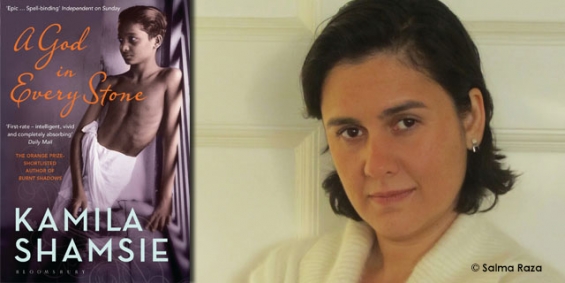Author spotlight: Kamila Shamsie
8th June, 2015
Our final spotlight is on Kamila Shamsie, author of A God in Every Stone. Here Kamila answers some questions about how she writes, and being shortlisted for the Prize.
What do you think about being shortlisted for the Walter Scott Prize for Historical Fiction? Do you see yourself as a historical novelist?
When you spend three years on a book, getting it horribly wrong at points and deleting ten months of writing along the way, it is a huge joy to know that a group of very well read people have chosen to tell you, ‘yes, it works.’ So of course I’m delighted. Although A God In Every Stone is the first of my novels to deal exclusively with the past, I’ve always been a writer interested in history – whether that history is unfolding around us or has happened a long time ago. And I also think history is always also about the present – at least, in my writing of it. So I suppose I would say I am concurrently a contemporary and historical novelist. Or perhaps I wouldn’t define myself at all – I write the novels, and let other peoples choose the categories in which to place them.
The Judges were struck by the huge themes and broad canvas of this novel. Is your writing all-consuming, and do you travel to these places to immerse yourself in the world?
Most of my travelling in the past took place in the British Library – the photography collection was particularly helpful in allowing me to ‘see’ Peshawar in the early 20th century. I did travel to Peshawar itself while halfway through writing the book, but with some trepidation. It’s a city so dramatically changed that I was worried that going there could muddy the picture I had it of it in my brain – as it turned out I was able to visit various of the locations that are in my novel, such as the Peshawar Museum, an early 20th century merchant’s house in the Walled City, the Mughal gateway of Gor Khatri etc. and find enough of the past still there to be both useful and spine-tingling. I didn’t go to the archaeologic site of Labraunda in Turkey, though – that pleasure still lies ahead. Perhaps the most dramatic of the visits was the one to the Brighton Pavilion – where they have a gallery of photographs from the days when it was used as a hospital for WWI Indian soldiers; trying to imagine what those young Indian men, subjects of the British Empire, made of the Pavilion when they first arrived there was a particular imaginative pleasure.
How did the people and times you write about in this novel first lodge in your imagination?
Writing a novel often allows you to find certain stories that have long ago lodged in your imagination and bring them together. I had been interested in Indian soldiers in the world wars since discovering letters that my great-uncle wrote home to his family in India while a POW in Italy during WW2. Archaeologists had always been a source of fascination, stemming from my childhood love for ancient history. And, about ten years ago I became intrigued by the non-violent anti-colonial movement among the Pashtuns/Pathans of the subcontinent, after reading a book called The Pathan Unarmed. The city of Peshawar became the magnetic force that pulled these different fascinations together.
At which point do you let fiction take over from fact?
Fiction never takes over from fact; it is entwined with fact.
Kamila Shamsie’s book A God in Every Stone is published by Bloomsbury.
Follow Kamila on Twitter – @Kamilashamsie
Find out who’s won the 2015 Walter Scott Prize at 5.15pm on Saturday 15 June
Buy tickets

